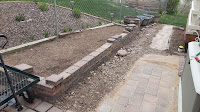Putting our time to some good use during this social distancing.
My wife joined a group of home bound seamstresses who have been sewing masks for low income families. Eventually the group got a call to make masks for First Responders. At last count they had made 33,218 masks.
 |
| 1 of 33,218 masks |
She has also continued with her painting.
And my favorite.
Keeping busy knitting and crocheting Christmas presents for her nieces and nephews.
 |
| Llama |
I on the other hand did some rather pedestrian projects.
I used some old pavers to build a raised vegetable garden for her zucchini and pumpkin patch and then a paved walkway so she could get to it.
And some mixed results carving tagua nuts.








Patti's paintings are fantastic! Tell her my favorite is the three giraffes and Mt. Kilimanjaro! Your carvings are impressive as well. I can see why your hands are sore from the pavers. I could never do that.
ReplyDeleteWow !! It seems you are both artists! I enjoyed seeing your work, those carvings are awesome! :)
ReplyDelete